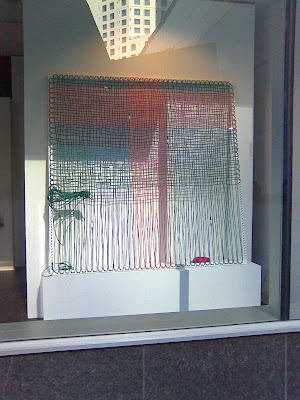I've been to a couple of events this week which have explored the balancing act between expert and amateur knowledge. Whilst many argue for one or the other, fearing exclusivity or dumbing down, others seek to find ways of facilitating the relationship between the two with integrity. It's not an easy task, whether running an art gallery, curating an exhibition or teaching a seminar, or even learning to code or knit. We need good data, referenced information, difficult ideas and questions, inspiration. But we need to communicate on a variety of levels and in a range of styles so that others can find their way in, or contribute their voice, or be inspired to act.
On Wednesday
VAGA hosted a discussion on 'Making the Case' for art in the face of massively reduced public spending. The collapse of the financial institutions has been a catalyst for a paradigm shift that provides a space for age-old concepts such as the ‘no-growth economy’, participation, and review of how we define ‘culture’. The idea that culture might be something we do, as well as something held in galleries was mooted, gently. But rather than instrumentalising art for a social agenda, Jude Kelley argued for support for artists to develop their practice with open-ended outcomes whilst located within communities. Gallery Directors outlined their support for artists in their regions, and Godfrey Worsdale called for an appreciation of ‘
connoisseurship’ and a respect for intellectual and creative enquiry.
Online tools for social networking and distributed media were also discussed as helping to understand the paradigm shift towards user-generated culture. But it’s important to remember that these are just tools, manipulated by mass-marketeers as well as communities of interest. It is within these communities of interest that the connoisseur, the novice and the expert can come to together to investigate their common passions. Learning within art galleries brings together all interested parties to individually or collectively explore critical ideas and creative experience.
The argument seemed to focus on the need to recognize art and artists as part of our broader cultural life. And to value the institutions that support them. In many ways I agree, art is also part of culture outside galleries, and a worthy subject of Cultural Studies in itself (although rarely so). By focusing on popular culture, Cultural Studies glides over the way in which artists intervene within, and investigate, other kinds of cultural activity too. I think this division between 'high' and 'pop' culture in academic research hasn't helped anyone to understand art as part of the world.
Returning to
Goldsmiths Teaching and Learning Course, the discussion was also about how to communicate expert knowledge and inspire others to undertake their own research. The group of new lecturers were motivated to develop a range of tools for engaging students in their own learning process. A deconstruction of the 'transmission model' of top-down lecturing and workshop sessions provided a convivial atmosphere for us to share our experience and knowledge of a range of teaching methods. Whilst respecting rigorous research we learned the importance of not knowing, of critical questioning, and trusting an open framework to give people time and space to think for themselves.
The same strategies can be applied to the role of the gallery, and the role of the curator. And I’m looking forward to finding out how the new Curating Students at Goldsmiths are going to balance their 'open connoisseurship' in their research and practice.
